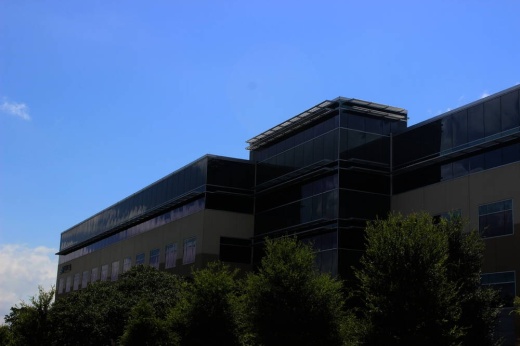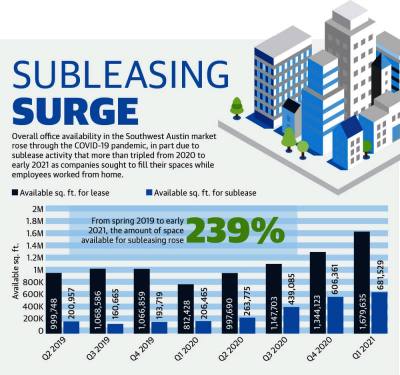The migration is having an effect on the subleasing market that surged during the COVID-19 pandemic.
In spring and summer 2020, businesses and property owners scrambled to figure out how to handle office spaces they were no longer regularly using.
One emerging practice saw tenants seeking some return on the leases they were still paying while their employees worked from home, resulting in demand for subleasing that rose citywide and within the Southwest Austin area.
“Pre-[COVID-19], subleases were pretty rare. They were very coveted, and they weren’t always happening,” Aquila Commercial Vice President Max McDonald said. “In [COVID-19], the subleasing was a little more straightforward.”
Over the past year, Aquila tracked quarterly sublease availability that rose to several times prepandemic levels, eventually peaking in early 2021 and taking up more than three times the share of Southwest Austin’s office market compared with late 2019.
Subleased offices also proved attractive over the past year in part given their furnished status, more flexible terms and discounted rates over direct leases with landlords.
Halfway through 2021, however, market analysts are seeing a sharp downturn in sublease activity with in-person work once again becoming commonplace and many companies reconsidering their future approach at the office, said Elizabeth Ansbro of global real estate services company JLL.
“In the first half of the year we’ve already seen 1.7 million square feet of sublease space removed,” Ansbro said. “And whether that’s because it’s been subleased or the term has lapsed or companies have actually withdrawn them ... more and more of those really ready-to-go, cool, plug-and-play spaces are going away.”
With a projected shift away from subleasing ongoing, analysts are also looking at a return to prospective tenants’ focus on newer spaces in the city. That includes the hundreds of thousands of new or anticipated Class A offices under construction or coming soon to the local market.
“Now that sublease availability is going away, we’re starting to see everybody spill over to the direct space. ... The only thing that’s going to be left is direct space, and that’s kind of what we had pre-COVID where our sublease availability was so minuscule that it was almost nonexistent,” JLL Research Manager Ali Bawany said.
Other pandemic-era shifts include tenants’ views of locating downtown and the desire for improved in-office amenities and health precautions. How extensive those changes will be as more offices return to in-person work remains to be seen, analysts said.
As more employees return to in-person work, that is also expected to bring more leasing activity than usual during the typically slower summer months as businesses decide what shape their office practices will take through the back half of 2021.
Ansbro and McDonald both said they have heard from many tenants targeting late summer through early fall to fully return to the office or offer employees flexible options. If they have not yet made that decision, that could set the stage for the city’s near-term leasing market as companies consider expanding, shrinking or maintaining their footprints.
“Over the last three or four months of this year, companies are going to learn a lot more about what their own futures and their decisions will look like. And that will allow them to make their real estate decision,” McDonald said.







